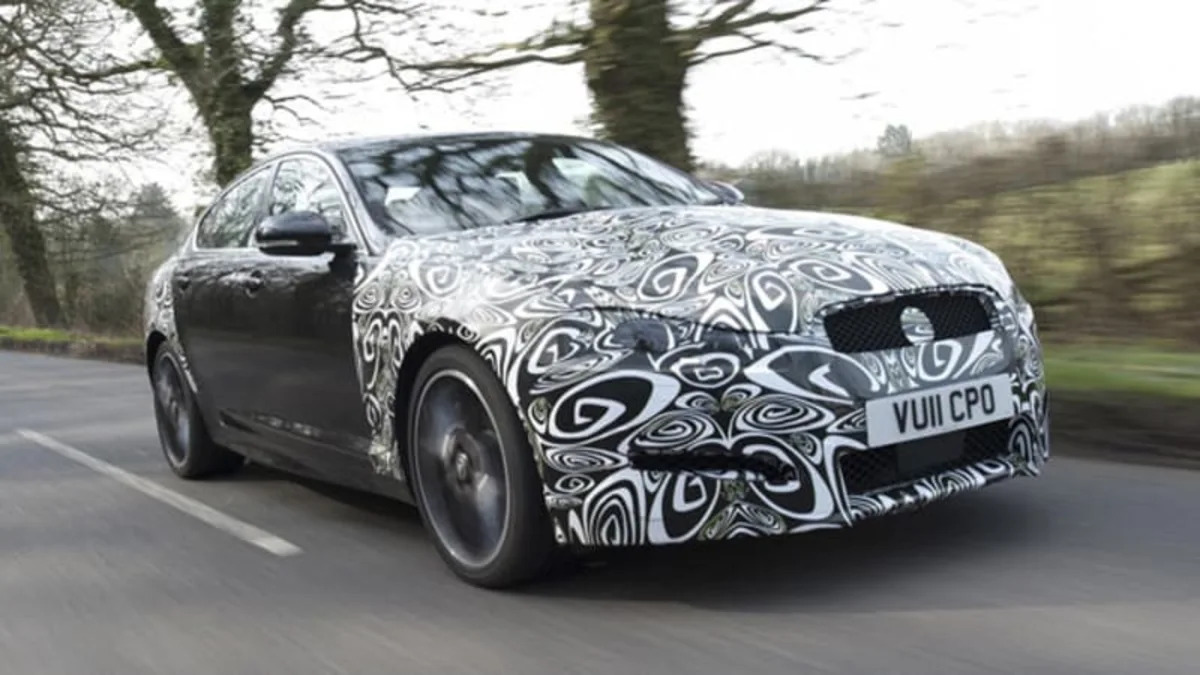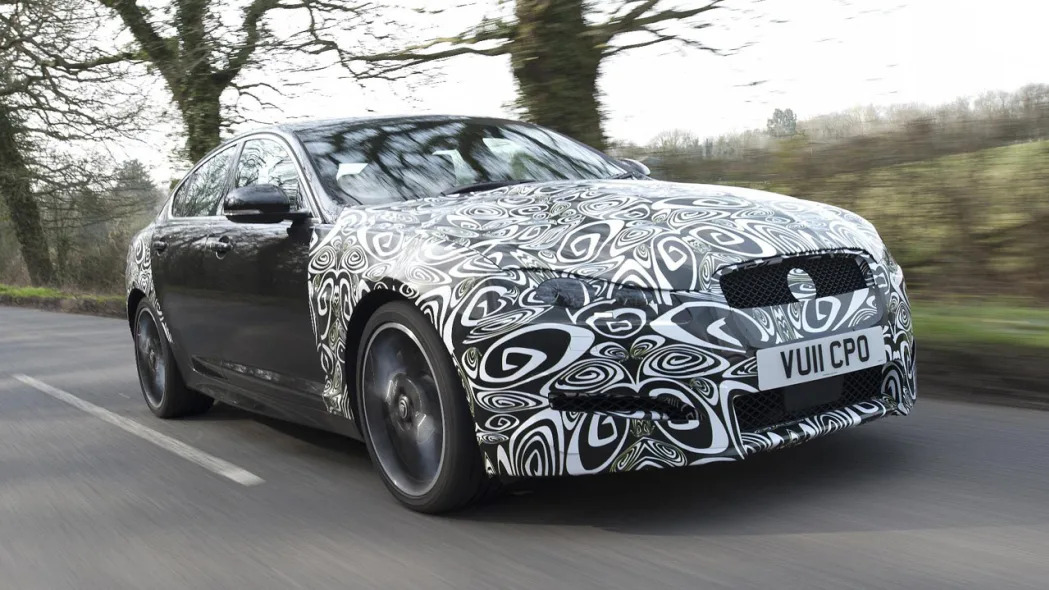2012 Jaguar XF Spy Shots – Click above for high-res image gallery
Jaguar has announced a new 2.2-liter diesel engine capable of 187 horsepower and 332 pound-feet of torque that can also travel 52.3 miles per gallon in the combined European cycle as fitted to a prototype of its 2012 XF sedan. The engine will also have little trouble meeting Europe's stringent CO2 regulations, as The Leaping Cat claims the engine only emits 149 g/km of CO2.
On the technology front, this new 16 valve common-rail diesel features a water-cooled turbocharger, low friction pistons, a fresh crankshaft and new injectors. Jaguar engineers also fitted a new oil pan and new electronic systems to allow for an intelligent Stop-Start system that operates more efficiently. The efficient little motor will work in concert with an also new eight-speed ZF transmission. Jaguar claims the diminutive diesel will propel the XF to 60 miles per hour in 8.5, while promising a top speed of 140 miles per hour.
As an added bonus, the folks at Jaguar were kind enough to pass us high-resolution photos of the refreshed XF undergoing testing. The camo is quite good, though we can see some alterations to the lower air dams, and we're guessing tail lamps, headlamps and the grille have also been given a once-over.
Jaguar says in the post-jump press release that the 2.2 diesel will make its way under the bonnet of a future XF production car, with "an estimated on-sale date being announced at the New York Auto Show." Keep in mind that the Big Apple show is international in scope, so assuming that a U.S. announcement means it will be sold here probably isn't a good idea. Hit the jump to read over the Jaguar press release.
[Source: Jaguar]
Jaguar has unveiled its most efficient engine yet in the form of a new 2.2-litre diesel unit.
Developing 190 PS and 332 lbs ft of torque, the new engine is capable of returning 52.3 mpg on the combined cycle while emitting 149 g/km of CO2.
Making its debut on UK roads fitted to a prototype development vehicle, the new four-cylinder 16-valve common rail diesel engine displaces 2,179 cc and is installed in a north-south configuration for the first time. The new engine features a water-cooled turbocharger with low-friction pistons, new injectors and a new crankshaft. The new configuration allowed Jaguar engineers to add a new oil pan and new electronic systems affecting the crankshaft to allow the new intelligent Stop-Start system to operate more efficiently.
Intelligent Stop-Start aims to reduce the prolonged time spent in the shutdown and start-up phase usually experienced in such systems. The Jaguar system overcomes this partly through the inclusion of the new crankshaft sensor and fuel rail pressure holding system meaning the engine needs less time to restore drive through an innovative engine restart capability. This is best demonstrated when approaching a busy roundabout – in situations where the driver briefly brings the vehicle to a stop only to move off again quickly. In conventional systems the engine needs to shutdown completely before restarting again, leading to often frustrating delays. The Jaguar system is able to restart the engine while it's shifting down from as little as 400 rpm meaning it does not need to come to a stop – drive is therefore restored more efficiently.
The inclusion of the Stop-Start function is estimated to increase overall fuel efficiency between five and seven per cent.
Along with a new engine, the development vehicle debuts an advanced eight-speed ZF automatic gearbox. With the seventh and eight ratios effectively acting as overdrive gears, the new gearbox allows the 2.2-litre engine to be optimised to deliver swift responses when required and effortless motorway cruising ability to ensure the ideal balance between efficiency and performance. The sprint to 62 mph takes 8.5 seconds before achieving a maximum speed of 140 mph.
The high levels of refinement expected of modern Jaguars are retained with engineers putting particular emphasis on sound deadening around the engine and bulkhead as well as active engine mounts to reduce vibration. The result is a 3dB reduction in cabin noise to make the car one of the most refined vehicles in its class.
The new powertrain will feature in a future XF production car with specifications and an estimated on-sale date being announced at the New York Auto Show.
Developing 190 PS and 332 lbs ft of torque, the new engine is capable of returning 52.3 mpg on the combined cycle while emitting 149 g/km of CO2.
Making its debut on UK roads fitted to a prototype development vehicle, the new four-cylinder 16-valve common rail diesel engine displaces 2,179 cc and is installed in a north-south configuration for the first time. The new engine features a water-cooled turbocharger with low-friction pistons, new injectors and a new crankshaft. The new configuration allowed Jaguar engineers to add a new oil pan and new electronic systems affecting the crankshaft to allow the new intelligent Stop-Start system to operate more efficiently.
Intelligent Stop-Start aims to reduce the prolonged time spent in the shutdown and start-up phase usually experienced in such systems. The Jaguar system overcomes this partly through the inclusion of the new crankshaft sensor and fuel rail pressure holding system meaning the engine needs less time to restore drive through an innovative engine restart capability. This is best demonstrated when approaching a busy roundabout – in situations where the driver briefly brings the vehicle to a stop only to move off again quickly. In conventional systems the engine needs to shutdown completely before restarting again, leading to often frustrating delays. The Jaguar system is able to restart the engine while it's shifting down from as little as 400 rpm meaning it does not need to come to a stop – drive is therefore restored more efficiently.
The inclusion of the Stop-Start function is estimated to increase overall fuel efficiency between five and seven per cent.
Along with a new engine, the development vehicle debuts an advanced eight-speed ZF automatic gearbox. With the seventh and eight ratios effectively acting as overdrive gears, the new gearbox allows the 2.2-litre engine to be optimised to deliver swift responses when required and effortless motorway cruising ability to ensure the ideal balance between efficiency and performance. The sprint to 62 mph takes 8.5 seconds before achieving a maximum speed of 140 mph.
The high levels of refinement expected of modern Jaguars are retained with engineers putting particular emphasis on sound deadening around the engine and bulkhead as well as active engine mounts to reduce vibration. The result is a 3dB reduction in cabin noise to make the car one of the most refined vehicles in its class.
The new powertrain will feature in a future XF production car with specifications and an estimated on-sale date being announced at the New York Auto Show.



Sign in to post
Please sign in to leave a comment.
Continue